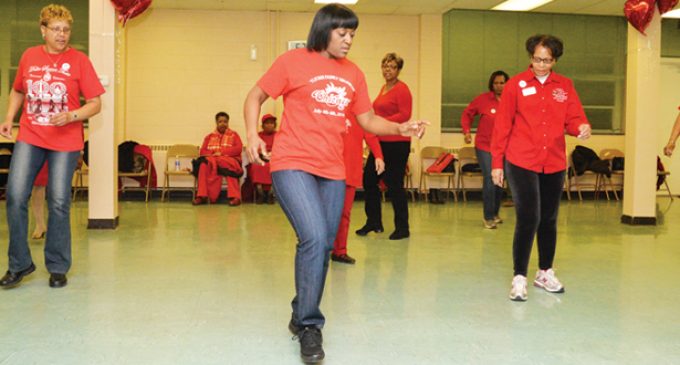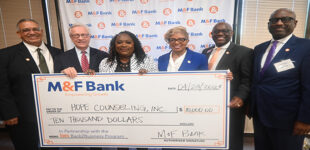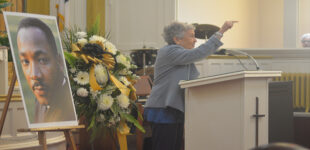Daylong heart health push draws hundreds

(pictured above: Cheryl Lindsay is the director of Human Resources and Inclusion/Diversity at Hanesbrands Inc., but to an ever-growing group, she is known for her annual efforts to raise heart health awareness.)
There’s no scarcity of activities on Go Red for Women day – a nationwide heart health call-to-arms. Programs throughout the Triad on Friday, Feb. 7 offered opportunities to get moving, motivated and educated.

Wells Fargo’s Peggy Reingold and WSSU Football Coach Kienus Boulware and W-S Dash mascot Bolt help Cheryl Lindsay (third from left) welcome attendees.
For the fifth straight year, Cheryl Lindsay played host to arguably the area’s signature Go Red event, and this year it was grander than ever. From 10 a.m. to 7 p.m., the gymnasium at the Gateway YWCA was an emporium of heart health. Nursing students and health and beauty professionals offering screenings, tips and information flanked a sea of enthusiastic exercisers taking part in marathon Zumba sessions. Dining tables – with bright red tablecloths, of course – provided a place to enjoy fruit and other fresh, brightly-colored vittles.
On previous Go Red days, Lindsay’s Red H.E.A.R.R.T (Help Educate And Reduce Risk Today) health initiative has staged everything from fitness flash mobs at Hanes Mall to a Guinness World Records-setting exercise session with hundreds of school kids. Red H.E.A.R.R.T activities specifically for senior citizens were held for the first time this year. Dozens of them kicked off the day with line dancing and water aerobics. Specialty activities for kids and teens followed. The event culminated with an evening collage of activities for families and men and women of all ages.
“It is important to keep moving,” said Lindsay, who tries to avoid using the word exercise, as so many dread that verb.
Researchers say that 80 percent of heart disease cases are preventable, especially among women. Red H.E.A.R.R.T is a tribute to Lindsay’s mom, Gail, one of the millions of women who died long before the medical community sounded the alarm about women’s heart health. Heart disease, by far, is the top killer of Americans, men and women. But the stealth way the disease attacks otherwise healthy women became a cause of national concern about 10 years ago, spawning the American Heart Association’s Go Red for Women campaign and a slew of other efforts like it. The AHA says the increased attention has had an impact. Since 2003, when heart disease was annually claiming the lives of about 500,000 women, there has been a 21 percent drop in heart-related deaths among women, and 23 percent more women are aware of the unique heart risks they face – Lindsay among them.
Shortly before she started Red H.E.A.R.R.T., she learned that her blood pressure was dangerously high, although she maintained a healthy weight and a pretty active lifestyle.
“‘Being thin does not matter,’” Lindsay said, repeating what she was told by a doctor. “It is your overall health and your numbers. You have to know your numbers.”
Lindsay again partnered with the Winston-Salem State University School of Health Sciences so that the estimated 900 people who took part last week’s event could leave knowing at least some of their numbers. As professor Dr. Jeanette McClain supervised, nursing students took blood pressure and body mass index (BMI) readings. (The AMA also recommends regular cholesterol and blood sugar screenings.) McClain says without fail, students find people in dire need of medical attention at each community health event they attend.
“The value of screening is so important,” said McClain, who contends “the silent killer” wouldn’t be so muted if screenings were utilized more.
Ona James and Jerricka Smith were screened by the nursing students. Both exercise science students at Salem College, James and Smith say though they are young, they are not naive about the dangers of heart disease. The same can’t be said about their college peers, however.
“They aren’t, but they should be, though,” Smith said.
While women are the focus of Go Red events, McClain says she finds black men are still most reticent to take control of their health and too often use the doctor’s office as a last resort. In recent years, Lindsay, a HanesBrands executive, has tailored her Go Red events for women, men and kids. She knows firsthand heart disease affects the whole family. Her two uncles – the only siblings of Lindsay’s late mother – have each had heart scares, despite outwardly being pictures of perfect health. Lindsay says her family history weighs heavy on her as she thinks about her own two preteen sons, and she gets misty over the realization that in two years, when she’ll be 46, she’ll be the same age her mother was when a massive heart attack claimed her life.
“I don’t want other kids to lose their mothers; I don’t want brothers to lose their sisters,” Lindsay said.
More images here: https://www.facebook.com/media/set/?set=a.721463861219152.1073741881.355902327775309&type=1&l=659dc7e727


















